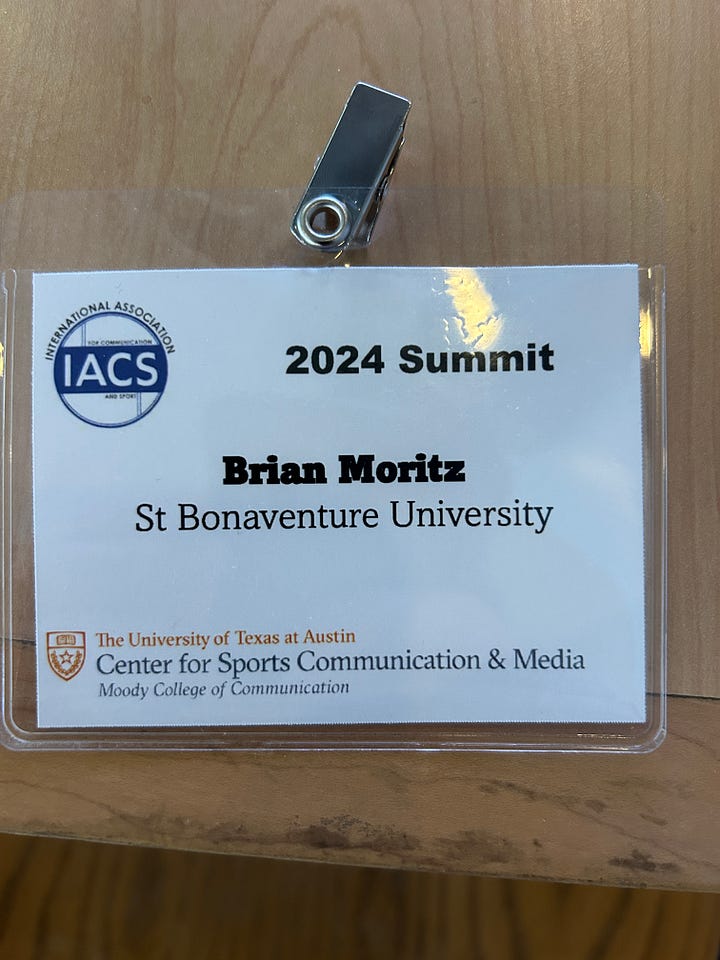Research recap: IACS 2024
The coolest sports journalism research presented at the Summit on Communication and Sport
LOS ANGELES, Calif. — A group of us came to the realization during the start-of-conference reception at Stadium Club at Dodger Stadium.
The 2024 Summit on Communication and Sport was probably the last academic conference for a long time with no studies about Taylor Swift and Travis Kelce. Certainly the last sports media conference without any Travis-Taylor studies.
The reason there were none this year was purely time and logistics. The deadline to submit abstracts was Sept. 29 — just five days after Taylor made her first appearance at a Chiefs game. That’s not nearly enough time to put together a study and have meaningful results that would be accepted at a major conference.


But enough about what wasn’t there. Let’s talk about the incredible research that was presented at the three-day conference, hosted by IACS and the University of Texas at their Burbank campus.
I presented my research into Stanley Woodward, Jack Mann, and their impact on the creation of modern sports journalism.
What follows is a recap of some of the sports journalism-related studies that I found particularly interesting. It’s by no means exhaustive (I didn’t attend every session) and not a judgment on the quality of any study not included.
John Shrader at the University of Nebraska presented research he did on the young generation of soccer play-by-play broadcasters in the U.S. Shrader said that soccer was the best place in sports broadcasting to see who we really are as a country — more soccer broadcasters are women and/or multilingual than you see in football or other traditional sports. Soccer is also a center of innovation in sports broadcasting. It was the first sport to embrace streaming, and as Shrader pointed out, soccer fans will pay to stream games.
Shrader also discussed how many of these soccer announcers do not attend games in person but instead call games remotely, either from their homes or from their broadcast houses in Florida. They watch the games on monitors, are connected to the director through an earpiece, and call play-by-play from what they watch. Shrader said that the announcers told him they have crowd noise pumped into their earpieces, which can help them capture the energy of a stadium they’re not in. While not ideal, this does allow companies to air more games. Shrader quoted a United Soccer League executive who said, “We can produce 25% of the games and be in the stadium or produce 100% of the games and get them on the air. ”
The research team of Tim Mirabito (Ithaca College) and John Collette and Jack Talbott (both from Gonzaga) presented a pair of studies based on interviews with local TV sports broadcasters. One focused on why local TV anchors leave the business, the other focused specifically on women anchors/reporters.
Looking at the study they did on women sports anchors, a few things stood out to me. One was, of course, the fact that women make less then men who have similar jobs. Another was the casual sexism that women still face in sports TV, not just from jerks on Twitter but from their bosses and sources.
The team found four themes that explain why women leave the sports TV industry: Newsroom leadership challenges, future family focus, shifting expectations, and being overlooked for opportunities.
A research team from Kent State did a study on the perseverance of women sports journalists. Cheryl Ann Lambert presented on behalf of the team. “We argue that their gender identities foster a sense of resilience.”
A notable (and wonderful thing) about this study was that it included women journalists from Africa and Latin America, not just the Global North (US and UK). The study found six themes from the women’s experiences in being resillient in the face of the patriarchy: managing mundane sexism, embracing and resisting gender roles, creating community online, taking a stand, establishing systems of support, earning confidence. The team found:
Women sports journalists continue to persevere in their individual workplaces, and in the industry at large. They do so through a combination of grit and determination, often working harder than their male peers. Colleagues and media consumers alike hold high expectations for how women sports journalists present themselves. Study participants are, thus, strategic with their use of voice.
Women sports journalists' experiences regarding gendered incivility reflects societal norms. They are expected to conform to certain gender role characteristics, but adhering to such roles doesn’t guarantee success. Structural obstacles and difficulties continue to mark the presence of women in sports media, leading to resilience among those that persist. Performing well necessitates sacrifices.
Aaron Gallagher, a Ph.D. student and Fulbright Scholar from the University of Dublin, presented his research into how Irish sports journalists’ viewed their roles in covering the Olympics, with a focus on Michelle Smith in 1996. Gallagher found that Irish reporters felt they were able to balance their roles of being critical when needed while also celebrating great athletic feats. Gallagher did find that they wished they had covered Smith’s controversy in 1996 better.
Bo Li, Brody Ruihley, and Jacob Orona from Miami University presented a study that explored traditional sports journalists’ perceptions of accrediting content creators at major sporting events. The challenge is because content creators tend to be more positive toward athletes, even celebratory in person, which not only challenges the “no cheering in the press box” professional norm, it also potentially makes it harder for journalists to do their jobs.
What’s interesting to me is that this is like the journalist-blogger wars of the early 2000s dressed up in TikTok terminology. But also - it’s long been an article of faith for me that bloggers (and, I guess, content creators) shouldn’t want to be in the press box. Because it limits them. It forces them to play by the rules of the press box. Their strength comes from their lack of access. But I get creators wanting to be there — video is the currency of the realm.
Finally, my old podcasting pal Galen Clavio and Kristin Wells from Indiana University, presented their agenda-setting study on the Front Office Sports newsletter, which has 825,000 subscribers (for reference, The Athletic has 1.2 million subscribers).
They found that the newsletter overwhelmingly focused on men’s sports — only six of the 115 stories they analyzed were about men’s sports. The newsletter’s primary focus is on leagues, teams, and events, with more prominent coverage of soccer and college sports than traditional sports media outlets. They also found that the writing is also more accessible and less like traditional sports business journalism newsletters.
Travelog: Los Angeles
This conference was just the second time I’ve been to Los Angeles (the first came on a St. Bonaventure basketball trip to Pepperdine a lifetime ago), and the first time my wife and daughter had ever been.
A top-five list of LA stuff:
If this photo puts a song in your head, we grew up at the same time and can absolutely be friends.
Downtown Burbank is lovely. Great low-key but vibrant vibe, a walkable main street with a bunch of lovely restaurants and shops.
When we were planning the trip, we heard from pretty much everyone that the Warner Brothers Studio Tour was the best of all of them. Can confirm. It’s fantastic. For movie and TV buffs, it’s perfection. My Gilmore Girls-obsessed daughter loved walking around the square that served as the set for Stars Hollow (fun fact — that was also the scene for You Got Trouble in The Music Man AND Life’s a Happy Song in The Muppets.)
Universal Studios Hollywood, the theme park/studio tour, is so much fun. Super Mario World is flawless, and The Simpsons world was this nerd’s paradise.
Dodger Stadium is gorgeous, even at night. It’s as if Mad Men were a baseball stadium, and it’s a great place to spend an evening. And yes, Dodger Dogs are delicious.





Any way to check out these studies? They sound pretty interesting!